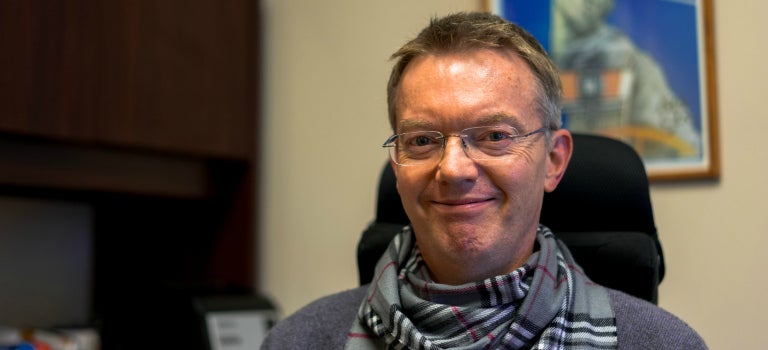Understanding Emotions Through Music, Culture, and the Internet

W. Gerrod Parrott is a professor of psychology in Georgetown College who studies the nature of human emotion. Photo by Alex Hu.
March 22, 2016—When Georgetown College psychology professor W. Gerrod Parrott was an undergraduate himself, he had no plans to study psychology. He was on the pre-med track with additional interests in music and Russian culture.
“But there was one summer, I came home pre-registered for pre-med courses and went back [to school] at the end of the summer and chucked it all,” Parrott says. “I ended up formulating an interdisciplinary major. I got interested in the relation between the way people think and the language that they speak. I ended up taking a collection of philosophy of language, anthropological linguistics, communications studies, and quite a bit of psychology.”
He continued his psychology studies in graduate school. There, he initially focused on analogical problem solving, or how people seek similarities between different things to gain a better understanding of new or unfamiliar material.
However, Parrott found himself turning away from this approach. “[I had] a sense of dissatisfaction that people were actually thinking as logically as this approach [suggested]. I found myself drawn to emotions as a counter-balance to that,” he recalls. “I started off very intrigued by the relation between the way you think and the way you feel.”
Early experiments tapped into his interest in music. “When I first came to Georgetown, the first thing I did was to set up some listening booths with speakers where people could be listening [to music] and making judgments. I was really looking at how [music] was affecting their moods and their moods were affecting their thoughts.”
He also tried more naturalistic experiments outside the laboratory, which is where he noticed an intriguing pattern: in the real world, rather than in the lab, certain negative moods seemed to lead to more productivity than positive moods.
As Parrott points out, this makes sense if you think about the music people choose when they are studying versus the music they listen to when getting ready for a night on the town.
“People will actually switch tracks,” he notes. “They have one thing that helps keep them focused, and they have another one that makes them energetic and bouncy. They switch channels to adjust their moods. I think they’re actually much more deliberate about it than they know.”
Similarly, he found that when interviewing students heading into the library on a sunny day, they were more likely to recall sad memories as they got down to work than students studying on gloomy days. Parrott theorizes that “people were using [sad memories] to bring themselves back to neutral. They had to go study, so if they were all happy from the sunny weather, they could bring themselves down.”
This eventually led him to serve as the editor for and contributor to the book The Positive Side of Negative Emotions. In it, he and others in the field defend negative emotions, including sadness, envy, embarrassment, and guilt among others, and demonstrate how they can be useful or even preferable in some cases to positive emotions.
He has met with disagreement in his field. “People would say, ‘We can understand why you would try to cheer yourself up with happier memories. But why would you try to make yourself feel sadder?’” he remembers. “That really has led me to a bunch of questions I’m still working on.”
These questions brought him back to another one of his undergraduate interests: Russian culture. Along with Georgetown College colleague Yulia Chentsova Dutton, a native Russian, Parrott is looking at how cultural attitudes about feelings influence a person’s ability to perform complicated cognitive tasks.
“Americans think they’d do better if they’re happy,” he says. “The Russians think, ‘If I’m sad, I’ll be calm. I’ll be in a balanced state of mind. I’ll be a little more sober, and I can do the job better.’”
Through concurrent studies in both countries, Parrott and Professor Chentsova Dutton are developing their own questionnaire in Russian and English that will try to get at these different attitudes and their effects.
When not in Moscow, Parrott draws insight from his students.
“If you looked at the five [emotions] that I study a lot–embarrassment, envy, jealousy, shame, guilt—they are interesting, complicated, messy social constructions,” he shares. “College students are a very sociable group on the whole. They have good intuitions about these things.”
“I actually find them very helpful in keeping me up to date with the changes that are taking place,” he adds. “Because I studied jealousy at a time where there wasn’t Facebook, there wasn’t texting, there wasn’t email, I will talk about the issues that give rise to jealousy and ask them to update me. They just come alive. The same emotions are alive and well, but in this completely new electronic, Internet environment.”
As for what he hopes his students gain from his classes, Parrott says, “I’m really aiming to increase their emotional intelligence in a way. They can understand how their emotions alter their thinking and how they’re motivated to do different things.”